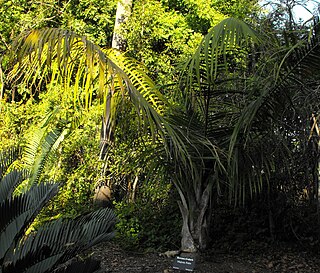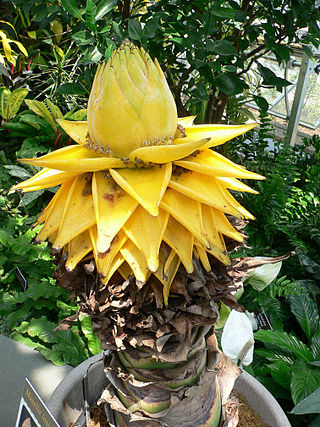
A banana is an elongated, edible fruit – botanically a berry – produced by several kinds of large treelike herbaceous flowering plants in the genus Musa. In some countries, cooking bananas are called plantains, distinguishing them from dessert bananas. The fruit is variable in size, color and firmness, but is usually elongated and curved, with soft flesh rich in starch covered with a peel, which may have a variety of colors when ripe. It grows upward in clusters near the top of the plant. Almost all modern edible seedless (parthenocarp) cultivated bananas come from two wild species – Musa acuminata and Musa balbisiana, or hybrids of them.

Musaceae is a family of flowering plants composed of three genera with about 91 known species, placed in the order Zingiberales. The family is native to the tropics of Africa and Asia. The plants have a large herbaceous growth habit with leaves with overlapping basal sheaths that form a pseudostem making some members appear to be woody trees. In most treatments, the family has three genera, Musa, Musella and Ensete. Cultivated bananas are commercially important members of the family, and many others are grown as ornamental plants.

Ensete is a genus of monocarpic flowering plants native to tropical regions of Africa and Asia. It is one of the three genera in the banana family, Musaceae, and includes the false banana or enset, an economically important food crop in Ethiopia.
Takhtajania is a genus of flowering plants of the family Winteraceae, which contains a single species, Takhtajania perrieri. It is endemic to Madagascar.

Joseph Marie Henry Alfred Perrier de la Bâthie was a French botanist who specialized in the plants of Madagascar.

Musa is one of three genera in the family Musaceae. The genus includes 83 species of flowering plants producing edible bananas and plantains, and fiber (abacá), used to make paper and cloth. Though they grow as high as trees, banana and plantain plants are not woody and their apparent "stem" is made up of the bases of the huge leaf stalks. Thus, they are technically gigantic herbaceous plants.

Ravenea is a genus of 20 known species of palms, all native to Madagascar and the Comoros.

Intsia bijuga, commonly known as Borneo teak, ipil, Johnstone River teak, and kwila, amongst many other names, is a species of tree in the flowering plant family Fabaceae, native to coastal areas from east Africa, through India and Southeast Asia to Australia and the western Pacific. It has significant importance to indigenous cultures in many parts of its range, but is also threatened by illegal logging due to its high quality timber. It is most commonly found in tropical coastal forests.

Musella lasiocarpa, commonly known as Chinese dwarf banana, golden lotus banana or Chinese yellow banana, is the sole species in the genus Musella. It is thus a close relative of bananas, and also a member of the family Musaceae.

Adansonia perrieri, or Perrier's baobab, is a critically endangered species of deciduous tree, in the genus Adansonia. This species is endemic to northern Madagascar. It has been documented in only 10 locations, including the Ankarana, Ampasindava, Loky Manambato and Montagne d'Ambre protected areas. Most populations, however, are outside of protected areas. Each location has few individuals. With an estimated population of fewer than 250 mature individuals and ongoing habitat decline due to fire and cutting for charcoal and timber or clearing for mining, this species has been assessed by IUCN as Critically Endangered. There are three species of baobab found in northern Madagascar, all sharing the common name "bozy".

Ensete superbum is a species of banana from India.

Musa acuminata is a species of banana native to Southern Asia, its range comprising the Indian Subcontinent and Southeast Asia. Many of the modern edible dessert bananas are from this species, although some are hybrids with Musa balbisiana. First cultivated by humans around 8000 BCE, it is one of the early examples of domesticated plants.

Ensete ventricosum, commonly known as enset or ensete, Ethiopian banana, Abyssinian banana, pseudo-banana, false banana and wild banana, is a species of flowering plant in the banana family Musaceae. The domesticated form of the plant is cultivated only in Ethiopia, where it provides the staple food for approximately 20 million people. The name Ensete ventricosum was first published in the Kew Bulletin 1947, p. 101. Its synonyms include Musa arnoldiana De Wild., Musa ventricosa Welw. and Musa ensete J. F. Gmelin. In its wild form, it is native to the eastern edge of the Great African Plateau, extending northwards from South Africa through Mozambique, Zimbabwe, Malawi, Kenya, Uganda and Tanzania to Ethiopia, and west to the Congo, being found in high-rainfall forests on mountains, and along forested ravines and streams.
Ensete glaucum, the snow banana, has also been classified as Musa nepalensis, Ensete giganteum, or Ensete wilsonii.

Ernest Entwistle Cheesman, was an English botanist noted for his work on the family Musaceae. He was the son of Charles Cheesman and Grace Lizzie Davies. About August 1936 he married Ellen Elizabeth B. Weston (1892-1966).

Dillenia alata, commonly known as red beech, golden guinea flower or golden guinea tree, is a tree in the Dilleniaceae family, found in New Guinea, and the Northern Territory and Queensland in Australia. It has found some popularity as an ornamental for tropical parks and large gardens due to its colourful flowers and fruit.
Henri Lucien Jumelle was a French botanist.

Musa banksii is a species of wild banana, native to New Guinea and Australia (Queensland), and most likely introduced to Samoa. It was first described by Ferdinand von Mueller in 1863 from plants collected in Queensland, Australia. Thereafter, taxonomists have variously treated it as a unique species or as a subspecies of Musa acuminata. The first one to note an affinity with Musa acuminata was Ernest E. Cheesman in 1948. In 1957, Norman Simmonds reclassified it as a subspecies of Musa acuminata based on extensive field observations in New Guinea, Australia, and Samoa. In 1976, George Argent chose to treat it as a species.
Gereaua is a monotypic genus of flowering plants belonging to the family Sapindaceae. It only contains one species, Gereaua perrieri.
Jumelleanthus is a monotypic genus of flowering plants belonging to the family Malvaceae. It only contains one species, Jumelleanthus perrieriHochr.















